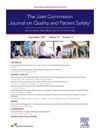心脏麻醉的安全干预:系统综述。
IF 2.4
Q2 HEALTH CARE SCIENCES & SERVICES
Joint Commission journal on quality and patient safety
Pub Date : 2024-12-20
DOI:10.1016/j.jcjq.2024.12.004
引用次数: 0
摘要
背景:心脏手术室是一个复杂、高风险的社会技术系统。心脏外科和麻醉学的风险已被广泛分类,但对有效的风险降低策略知之甚少。全面了解有效的、基于证据的风险降低策略对于提高心脏麻醉患者的安全性是必要的。方法:对MEDLINE、CINAHL、Embase和Web of Science数据库进行高级文献检索,以确定涉及在心脏麻醉中引入工具或干预措施以提高患者安全性和人为因素的研究。研究由两位作者应用预先规定的纳入和排除标准独立筛选。根据患者安全模型的系统工程倡议对确定的风险降低策略和安全举措进行分类。数据提取使用标准化的形式,并叙述合成。结果:共有18项研究被纳入术前简报工具、术中检查表和术后交接工具。术前简报工具与患者死亡率和住院时间的显著减少有关,也导致适应计划手术。术中检查表显示出血、死亡率和输血需求减少。术后交接工具与改进的信息传递和团队合作有关。结论:本综述确定了可用于改善患者和组织结果的三类工具。这些工具中的许多都很容易引入,并且长期可持续,可以很容易地适应不同的中心。本文章由计算机程序翻译,如有差异,请以英文原文为准。
Safety Interventions in Cardiac Anesthesia: A Systematic Review
Background
The cardiac operating room is a complex, high-risk, sociotechnical system. Risks in cardiac surgery and anesthesiology have been extensively categorized, but less is known about effective risk reduction strategies. A comprehensive understanding of effective, evidence-based risk reduction strategies is necessary to improve patient safety in cardiac anesthesia.
Methods
An advanced literature search of MEDLINE, CINAHL, Embase, and Web of Science databases was conducted to identify studies involving the introduction of a tool or intervention to improve patient safety and human factors in cardiac anesthesia. Studies were screened independently by two authors applying prespecified inclusion and exclusion criteria. Risk reduction strategies and safety initiatives identified were classified according to the Systems Engineering Initiative for Patient Safety model. Data were extracted using a standardized form and were narratively synthesized.
Results
A total of 18 studies were identified for inclusion using preoperative briefing tools, intraoperative checklists, and postoperative handover tools. Preoperative briefing tools were associated with a significant reduction in patient mortality and length of hospital stay and also led to adaptations to planned operation. Intraoperative checklists demonstrated decreased bleeding, mortality, and blood transfusion requirements. Postoperative handover tools were associated with improved information transfer and teamwork.
Conclusion
This review identified three categories of tools that may be used to improve patient and organizational outcomes. Many of these tools are simple to introduce and sustainable in the long term and can be readily adapted to different centers.
求助全文
通过发布文献求助,成功后即可免费获取论文全文。
去求助
来源期刊

Joint Commission journal on quality and patient safety
HEALTH CARE SCIENCES & SERVICES-
CiteScore
3.80
自引率
4.30%
发文量
116
审稿时长
49 days
 求助内容:
求助内容: 应助结果提醒方式:
应助结果提醒方式:


